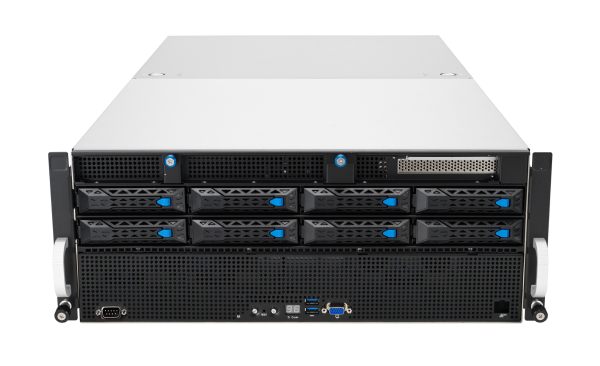
TAIPEI, Taiwan, July 12,, 2021 — ASUS, the leading IT company in server systems, server motherboards and workstations, today announced it has joined the influential MLCommons® MLPerf™ Training 2.0 benchmarks — and has secured 10 leading performance results with specific configurations of the ASUS ESC N4A-E11 and ESC 8000A-E11 servers.
ASUS is focused on creating complete, optimized solutions and strives to cultivate strong industry partnerships to enhance AI developments in diverse fields to push technology to its limits. In particular, the unique architecture in ESC N4A-E11 has achieved chart-topping scores across several benchmarks and AI disciplines.
The remarkable scores are a result of the ESC N4A-E11 server’s best-fit design, which includes one CPU and four NVIDIA Tensor Core GPUs. This enables the highest number of single-CPU cores and the most efficient GPU communications — empowering accelerated AI developments in research institutes, enterprise AI development and data center workloads.

ASUS achieved 10 leading performance results in MLPerf Training 2.0
As a new MLCommons member, ASUS is proud to have enrolled in the MLPerf Training 2.0 submission for 2022 — allowing its servers to be judged for their performance in the competitive field of AI training.
Specifically, the ASUS ESC N4A-E11 server was submitted because it’s considered the perfect choice for diverse AI workloads in simulation and data analytics, including virtualization, medical diagnoses and voice recognition. The ASUS ESC 8000A-E11 was also submitted for testing PCI Express® (PCIe®) solutions based on different use cases. Both excelled in their respective disciplines.
ESC N4A-E11, for example, secured seven leading positions in the benchmarks. This result is a testament to the benefits of ESC N4A-E11’s optimized hardware design, which features a single-CPU architecture with four GPUs to make the most efficient interconnects between CPU and GPU communications — as well as the highest efficiency NVIDIA NVLink® interconnect architecture. It is also a clear demonstration that ASUS is capable of fully embracing and utilizing the advantages of this hardware platform.
For its part, the ESC8000A-E11 scored three leading positions in the benchmarks with the configuration of dual AMD EPYC™ 7763 CPUs and eight NVIDIA A100 PCIe 80GB GPUs, exercising its prowess in being optimized for BERT, MASKRCNN, MINIGO, SSD, RNNT and UNET3D AI models across the fields of image recognition, voice recognition and reinforcement.
The unique design and benefits of ASUS ESC N4A-E11
With ESC N4A-E11, ASUS has expertly leveraged the CPU and GPU architecture to maximize performance through a powerful combination of the AMD EPYC 7773X and NVIDIA HGX A100 platforms. This optimized hardware design paired with ASUS-exclusive, firmware-based tuning technology speeds up overall efficiency and precision in AI training models.
ESC N4A-E11 is designed specifically for high-performance computing (HPC), and has been deployed in numerous HPC projects globally this year alone. ASUS successfully deployed ESC N4A-E11 at research institutes in the Middle East and showcased this unique design to be beneficial to AI research fields. In addition to its superior hardware design, ASUS also has exceptional services, from proof-of-concept and testing processes to final delivery to the end customer.
ASUS is an integrated-solutions partner delivering leading hardware for the fields of supercomputing and data centers, supported by an extensive AI portal and AI software stack. The MLPerf benchmarks help the company’s engineers to develop an ever-better understanding of AI applications and performance needs — and continue delivering innovations to both shape and grow MLCommons.
